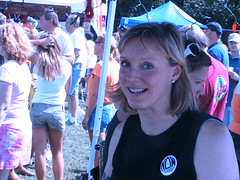Sci-Fi and Gender Roles: Why Does Zoe Have to Act Like a Man?
I am have been reborn as a Firefly fan. This science fiction show aired for only one season in 2002 on Fox. The show was too good to be renewed. This happens to many of the shows I have like, most recently Cupid, with Jeremy Piven.
Anyway, as I have been watching these firefly episodes, I can't help but wonder why science fiction never goes quite far enough in imagining a world far different than our own. Perhaps we need enough of the familiar to connect to the story and thereby become self-reflective of our plights. I started thinking about this in connection with the character Zoe. Zoe is a laconic, tough war hero. Mal, the captain, and Zoe have been in many battles and now are partners in crime on the ship Serenity. Zoe is a stunning black woman, with great self-possession and military loyalty. While she is gorgeous woman, everything about her character is masculine. In fact, she is the ideal man: skillful, brave, war hero, protective, faithful to her fellow crew, etc. She carries herself far more like a man would, especially when you compare her to Inara, the companion. Zoe is a woman of few words, direct, and loyal.
I watched the new Battlestar Galactica movie two nights ago and, again, starting thinking about the way Starbuck, recast as a woman, is even more masculine than Zoe. Now, many women are drawn to science fiction because it imagines worlds where women and formerly marginalized people are now equals, that is, they hold positions of authority, enjoy the respect of their peers, and ones' professional excellence is not tied to one's sex. There is no deliberating over whether Starbuck, a woman, can fly a fighter plane. She is the best, so no one sits around making jokes about being beat out by a woman. And yet, if you watch how Starbuck moves, her gestures: wide stance, brushes her thumbs over her nose with a smirk, swagger when she walks, prone to fighting--it's hard to ignore how masculine her features are.
So, in both Firefly and Battlestar Galactica you have these tough female icons in the future, but each of them more closely resemble men. The reason why you have such characters is because we understand there is a difference between sex and gender. One's sex is the biological self, whereas one's gender is the set of practices, behaviors, as well as cultural expectations of how you should be behave, that have typically been coordinated with one's sex. Starbuck and Zoe are the ideal of female attractiveness, and yet their characters are quite typical heroic male. The need for both of these women to be attractive and "kick ass" is interesting, since it shows a preference that only drop dead gorgeous women are allowed to be tough characters. At least a preference among viewers and fans of the show.
What I couldn't help but think about is why these shows cannot imagine more complex gender roles, or even imagine human interactions ungoverned by strict gender roles?. Taking Firefly for the moment: Why must the empathetic, sensitive character be a female: Inara. Why is the moral conscience a black man: Book? These are rather entrenched gender and racial stereotypes. Moreover, Zoe is a black woman--sexual and tough--another well entrenched stereotype. Now, on the whole, I love the show, the characters, the dialogue and the fact that the ship's mechanic is a woman--Kaylee. On the whole, the show imagines a world wherein the gender straigthjackkets we negotiate through now--whether male or female--are loosened.
But, why can't we imagine a "female" battle hero or captain who does not have to adopt quite typical male body language and poses to be taken seriously? The fact is that toughness is profoundly linked, in our popular imagination, with masculinity. Is it possible to break apart those gender roles and imagine admirable characters that are defined less by typical masculine or feminine traits (or racial stereotypes for that matter), and hence provide a window for us of a world wherein we move beyond these already archaic human artifacts?

|